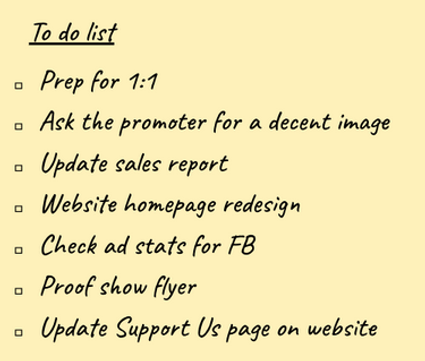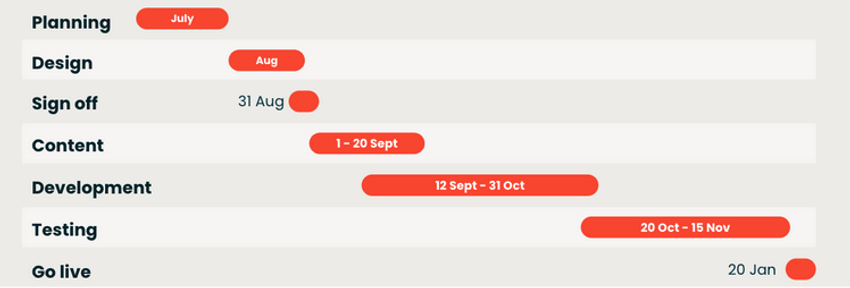How to succeed in Project Management …
A write-up of our session at AMA Conference 2024
Marketers in the cultural sector often work across multiple disciplines. But even if you’re a specialist, it's likely that things will often land on your desk that don’t fit that specialty.*
Whether it’s your season brochure, a new membership scheme, redesigned signage around the building, or a whole new brand or website, chances are some form of 'project management' will be part of your job. Even if it’s not in your job title.
I’m not a Project Manager either – but I’ve managed lots of projects. From introducing booking fees and system updates in theatres, to managing ticketing system migrations at Spektrix, to whole new website projects here at Supercool.
I consider myself a generalist and my workload is often very varied. But that doesn’t mean I can’t be great at Project Management – and the same goes for you!
In this post I'll cover what a project is, how to organise a project plan, and ways to keep stakeholders up-to-date. I'm hoping that by the end you’ll feel more prepared and more confident when it comes to project management.
*If you want to feel seen, I highly recommend Sam Freeman’s post Jack Of All, Master Of None.
What is a project?
One of the biggest challenges when you’re not a full-time Project Manager, is identifying which of the things on your to-do list are actually 'projects'. Getting this right means you can start on the right track, and avoid a project going off the rails further down the line.
A project can be defined as something that:
- Is not a repeated weekly/monthly task
- Will span a period of time
- Has an end date
- Involves multiple people/teams
Let’s take a typical to-do list for someone in Arts Marketing:

.
There are things on the list that are regular tasks – 'Prep for 1:1' for example. And some that are one-offs, like proofing a flyer. But there’s also (at least) one task that meets the criteria of a project: Website homepage design.
Here’s why this is a project:
- Is not a repeated weekly/monthly task – You might update content on the website homepage regularly, but you’re probably not going through a full redesign on a regular basis
- Will span a period of time – Depending on how much is going to change, it will likely take anything from a few weeks to a couple of months
- Has an end date – Perhaps you need to get it done for a season launch? Or it's been on your list for a while and you have set time aside for it. Either way, it will be 'done' at some point, so no longer on your to-do list
- Involves multiple people/teams – Lots of colleagues will have opinions about it, and you’ll need to work with your web agency
Now we’ve identified that the 'Website homepage redesign' is a project …
How to make a project plan:
If you take nothing else from this article, take this! Having a solid project plan is the golden ticket to being a better Project Manager.
1) Define your goals
Start by defining what it is you want to achieve. Consider how this can be measured, and how you’ll know if the project is a success. Ideally, you should only have 3 to 5 goals, and each one should be as measurable as possible.
These goals will help keep you – and the wider team – grounded at all stages of the project.
If a new feature, or change to the timeline, or a different creative direction is requested or suggested, you can refer back to your goals to decide if these changes will help you to achieve them. (Or if they aren’t important just now.)
2) Break the project into manageable chunks
A quick 10-minute brainstorm can help you break a project down into the various things that need to happen.
For a website homepage redesign, the various bits might look like this:

.
You don’t need to be too granular here, but it is worth noting everything you think you – or someone else – will need to do. And anything new you think you'll need. For example, you might need a new video for the homepage, to agree KPIs, get sign-off from stakeholders, and write some new copy.
Next, organise your list. And there’s no right or wrong way to do this – each Project Manager will tackle a project in their own way. And that’s okay.
So, don’t get too caught-up in finding the 'right' way. Instead, go with what seems logical to you. For example, I might organise the various bits of the project like this:

.
3) Create a schedule
Now that you have the bare bones of a structure, you can create a schedule. One of the biggest potential pitfalls of a project is a lack of schedule. Without a schedule, your project looks a bit like this:

.
Remember when I said a project plan was the golden ticket to managing projects?
That's because, without one you simply have a start and an end, with no steps in the middle.
If I pointed to any point of that long line, would you know what should have happened by then to keep your project on-track? Or what still needs doing? Would you know what’s on-time? Or what’s late? Would you know how likely it is that you'll get to the finish line on time?
The answer to all of those questions is "No"!
Having a project schedule will help you answer those questions. It creates a structure, milestones, and a means of measuring your progress.
Now, let’s group our 'Website homepage redesign' tasks into related phases:

.
This allows us to create a linear plan, which helps us visualise those phases of the project – in the order they need completing:

.
The next step is get more specific by adding dates:

.
And now we have a project plan!
There are clearly defined stages, with dates so you can track where you are, what’s done, and what’s still to do. And you’ll quickly be able to spot if things are going off track. This tool will also help you to share deadlines and updates with stakeholders.
There are lots of ways to put a project schedule together. Some Project Managers will use highly detailed tasks and charts. But for many projects, this kind of plan is perfectly adequate. And certainly better than no plan at all!
How to manage stakeholders
One of the hardest things to deal with when managing a project is all the people involved. Often you’ll be expected to manage up and across teams, manage external relationships, and potentially deal with some very different opinions!
There’a lot to be said for Project Managers being highly adaptable, and able to change how they communicate to suit the people around them. But I'd argue that, as someone who manages projects but isn’t a full-time Project Manager, there’s a lot you can do while staying in the comfort of your natural communication style. (I’d also argue that, in a truly inclusive workplace, you should be able to do this all the time.)
More than anything, it’s important to be useful – even if that takes more time, and slows things down a little. This might mean always communicating updates in writing, or asking a colleague to present at a Board Meeting in your place. That’s okay.
Get buy-in
To help successfully manage stakeholders, it’s worth getting buy-in right at the start. A few ways you can do this include running workshops or sending surveys (See Resources section at the end of the article). You can also arrange interviews where you spend time with individuals and listen to their needs.
Remember, in the early stages your purpose is to listen and gather information. It’s not to provide answers or make promises.
Asking open questions, giving people space to vent or moan, and reassuring them that they’ve been heard is more important than working out all the answers straight away.
When it comes to getting feedback partway through a project, be careful with your language, because there's a very real danger of people unpicking decisions that have
already been made. So, be very clear about what you're asking people to
feed back on, and provide some direction.
Remember – it’s fine to simply share an update, without asking for feedback!
Don’t say: “Let me know what you think!”
Do say: “Here’s where we’re at so far.”
Don’t say: “Let me know if you have any feedback!”
Do say: “At this stage, if there’s anything you feel is critically wrong or incorrect, let me know.”
Remember – it’s fine to simply share an update, without asking for feedback
“How’s the project going?”
When you’re managing a project, you’ll hear this a lot. From lots of different people. It might be your Chief Executive passing you in the office. Or your web agency looking for an update. Or a friend wanting to hear the gossip.
The important thing to remember is that each person asking you this is looking for slightly different information.
What does a Chief Exec really want to know when they ask how the project is going? They probably don’t want much detail, but they will be interested in whether it’s in-hand and running smoothly.
Your Manager may want to know a few things about the project itself – and you. They’ll want to know if you’re okay and coping with the workload. They’ll also want to know if there are any potential issues, blockers or whether you need anything from them.
Your web agency will be most interested in timelines, whether decisions have been made and ideas signed-off. They’ll probably also want to know if all the various stakeholders are happy with progress.
Working out what someone actually wants to know when they ask “How’s the project going?” can take time. So it’s okay for you to take your time too. It’s okay to say “Let me get back to you with an update”. It’s much better to take a moment, review your timeline, and consider what someone really needs, then send a useful email a bit later, than to blurt-out everything you can think of, the moment you’re asked.
To avoid surprise questions about the project, consider sharing regular updates. Again, do this in the format that best suits you:
- You might want to send a weekly email
- Perhaps keep a Status Document on a shared drive
- Or add it to the agenda of your regular team meetings.
This will help you stay in control of when you provide updates, and what you share.
Handy resources:
? Survey Template
(Great for collecting thoughts and ideas at the start of a project.)
? Status Doc template
Word download / Google Doc link
(Great for keeping track of progress and sharing updates)
? Decision Log template
Excel download / Google Sheets link
(Great for keeping track of decisions throughout your project)
Go forth – and manage those projects!
Hopefully you now feel a bit braver, and a bit more confident when it comes to project management. I want to leave you with these top tips:
- Always make a project plan
- Trust your instincts
- Use what you know, and what you’re comfortable with
Need help managing a project? Or want to chat-through the templates in this article? Get in touch – kate@supercooldesign.co.uk